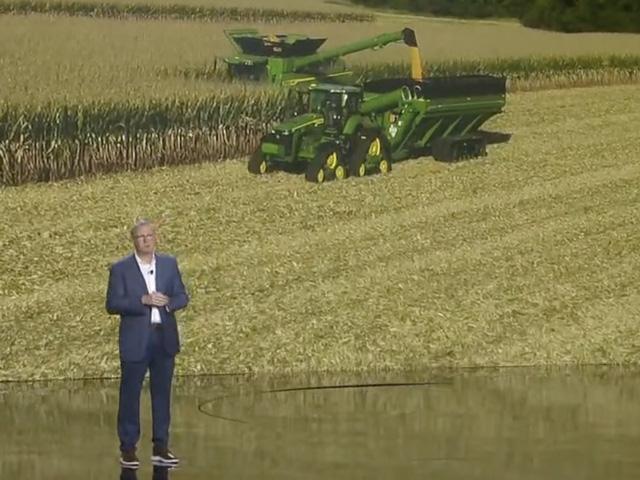Deere: Tech Creates Sustainability
Deere CEO Lays Out Tech Strategy for Ag Sustainable Growth at CES 2023
LAS VEGAS, Nevada (DTN) -- John Deere took center stage at the CES on Thursday, with Chairman and CEO John May delivering an opening keynote address focused on technology and sustainability before an audience of 2,000 gathered in the Venetian Palazzo Ballroom, and by extension to the expected 170,000-strong tech community (173 counties and territories) assembling here for one of the world's largest technology events.
May put Deere at the center of a technology revolution that seeks to feed a growing and hungry world but do it smartly and sustainably. In an era of declining arable land, a declining rural labor pool and rising input costs, "technology is the solution to these challenges," he said. "Technology allows farmers to create more with less," and he added, (Deere) has quickly become a leading player in that space as "one of the world's leading robotics and (artificial intelligence) companies."
It was the first-ever keynote opportunity for an agricultural company exhibiting at the CES, and Deere took the opportunity to announce a new robotic-based fertilizer system, laid out its approach to "sustainable" energies and offered a first look at a new electric excavator.
One technological opportunity for Deere is the application of fertilizer. Deere announced a new technology and robotic tool, ExactShot. ExactShot automates the application of starter fertilizer, spraying it only onto each corn seed as it is placed in the seed trench. (See "Deere Announces ExactShot" -- https://www.dtnpf.com/….)
ExactShot technology "allows farmers to apply starter fertilizer preciously at scale and at speeds up to 10 mph -- and only where the seeds are planted," said Deanna Kovar, vice president of production and precision ag production systems at Deere, from the CES stage.
There are high demands on ExactShot technology. A 24-row ExactEmerge planter puts down 720 seeds per second, 34 million seeds over a productive day. More accurately quoting Kovar, she described the row units in her example as "24 robots." Not a misspoken phrase to be sure, but an indication of where Deere's technology mind goes these days -- robots, not row units.
P[L1] D[0x0] M[300x250] OOP[F] ADUNIT[] T[]
ExactShot technology uses sensors and robotics to place starter fertilizer precisely onto seeds as they are planted in the soil rather than applying a continuous spray of fertilizer through the entire seed trench. At speed, ExactShot applies roughly a shot glass full of starter to 100 seeds every 2.5 seconds. "This combination of sensors and robotics delivers a massive cost saving to the farmer and a significant benefit to the environment," Kovar said.
Deere says ExactShot can reduce starter input applications by 60% -- or 93 million pounds -- for a savings of about $650 million a year. ExactShot is in the field, and testing is currently underway with farmers mainly in the Midwest, Iowa and Illinois to name two states. Deere says ExactShot will have limited availability for farmers this spring.
With ExactShot as an example, these technology-fueled times are changing quickly, May acknowledged. "When I began working in this industry 25 years ago, everyone focused on equipment and making that equipment larger and more powerful ... the bigger the equipment, the more efficient," he said. "That is fundamentally changing. Today farming ... is less about the size of the machine and more about technology and intelligence and sustainability. ... Doing more with less," May said, "that is the path forward to providing for all of us and feeding a growing world."
Tractors have become digital platforms, May said. Deere's newly launched 8R autonomous tractor relies on GPS, advanced sensors and integrated displays, benefits from cloud computing, high-level data analytics, visioning and machine learning. "These tractors aren't concept vehicles, they are real and being used on the farm today," May said.
Joining May and Kovar on the CES stage was Deere's Chief Technology Officer Jahmy Hindman. At the top of his presentation, he explained Deere's energy strategy for its powered lines. It is a mix of energy sources with advancements in internal combustion. He acknowledged Deere's strategy has some controversy in it.
"The path to a sustainable future does not rely only on electrification to power vehicles," Hindman told the CES attendees. "Biofuels, like ethanol and renewable diesel, which may be created from plants, must be just as much a part of the solution."
Large-scale electrification of high-horsepower equipment faces steep technological challenges that "make an electric-only future unlikely in the near term," Hindman said. For example, he said, a Deere 8R tractor working 14 hours per day at 75% of peak power would require the equivalent of 38 Tesla model batteries. That would double the weight of the 8R and quadruple its price.
Still, Deere is delivering on its promise to manufacture battery-electric machines.
Deere brought its new electric excavator to the CES. It is powered by a Kreisel battery that improves reliability, performance and safety in construction, Deere says. Its use on construction sites will result in fewer moving parts, less noise pollution, and fewer emissions. Deere owns a majority stake in Kreisel Electric. Its patented immersion cooling architecture provides improved performance for battery-powered equipment.
But in the end, Hindman said the operative word for the energy sources propelling ag equipment is "and" -- biofuels and battery electric and hybrid electric and advancements to internal combustion. "We need to meet the economic and efficiency needs of our global customers and because (this) is what it will take to meet our carbon emission goals."
Dan Miller can be reached at dan.miller@dtn.com
Follow him on Twitter @DMillerPF
(c) Copyright 2023 DTN, LLC. All rights reserved.




